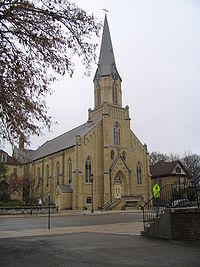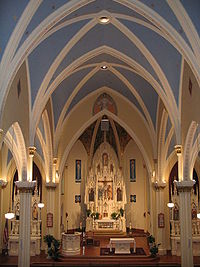
Guardian Angels Church
Encyclopedia


Chaska, Minnesota
As of 2005, there were 22,467 people and 8,194 households residing in the city. The population density was 1,640 people per square mile . There were 6,235 housing units at an average density of 454.1 per square mile...
founded in 1858. A Roman Catholic church, Guardian Angels is part of the Roman Catholic Archdiocese of Saint Paul and Minneapolis
Roman Catholic Archdiocese of Saint Paul and Minneapolis
The Roman Catholic Archdiocese of Saint Paul and Minneapolis is an ecclesiastical territory or diocese of the Catholic Church in the United States. It is led by the prelature of an archbishop which administers the archdiocese from the cities of Saint Paul and Minneapolis...
.
Guardian Angels School (School District 112), a pre-K to 8th grade private school, is affiliated with this church.
Parish history
The parish’s history dates back to 1842 when the fur trader J.B. Faribault invited Father Augustine Ravoux to establish a mission among the Sioux Indians in what would become the town of Chaska.Fr. Ravoux built a small log chapel and named the parish St. Francis Xavier, but dismantled the chapel three years later when the Native Americans saw the European immigration as a threat, and in turn threatened to burn the chapel down. The chapel was sold to German Catholic Christians in Wabasha and floated down the river to its new home.
In the 1850s the Benedictine
Benedictine
Benedictine refers to the spirituality and consecrated life in accordance with the Rule of St Benedict, written by Benedict of Nursia in the sixth century for the cenobitic communities he founded in central Italy. The most notable of these is Monte Cassino, the first monastery founded by Benedict...
Fathers made frequent visits to the Chaska area – mostly to German immigrant communities along the Minnesota River
Minnesota River
The Minnesota River is a tributary of the Mississippi River, approximately 332 miles long, in the U.S. state of Minnesota. It drains a watershed of nearly , in Minnesota and about in South Dakota and Iowa....
, formerly called St. Peter’s River – to determine whether a community was large enough to support a church.
Minnesota achieved statehood in 1858 and during that year the Benedictines decided that Chaska was able to support a church. The congregation had difficulty choosing a name for the new church, so they decided to have Michael Guenser's two-year-old daughter look at pictures of saints and select one. She chose the picture of the Guardian Angel
Guardian angel
A guardian angel is an angel assigned to protect and guide a particular person or group. Belief in guardian angels can be traced throughout all antiquity...
, and so the church was named Guardian Angels Catholic Church.
Since the first log chapel in 1842, three churches were built. The first was built between the years of 1858 and 1860. It was a simple, small brick building with planks on wooded blocks that served as pews.
In the mid-to-late-19th century, immigrants from Germany were fleeing official persecution of Catholic Christians in historically Catholic parts of Prussia and, later, the German Empire. They were flocking to familiar scenery in Wisconsin, Iowa and Minnesota, including the Minnesota River valley. Immigrants were also leaving the Netherlands (Holland) and Germany in search of land for growing families. The Dutch Catholics immigrating to the area were usually labeled as “destitute” by Dutch authorities.
By 1864, rapid population growth in the area saw the need for a larger church and in 1868 work began on a second church. This church served the community's needs until 1885 when construction began on the present church. This church, designed by John Geiser was built in Gothic Revival Style architecture. The new church was an imposing structure on the landscape, constructed of Chaska Brick with a steeple
Steeple (architecture)
A steeple, in architecture, is a tall tower on a building, often topped by a spire. Steeples are very common on Christian churches and cathedrals and the use of the term generally connotes a religious structure...
towering 162 feet above the street. The interior ceiling rose 39 feet above the floor. It was described as one of the most adorned structures in the area. The new building was dedicated by Bishop Thomas Langdon Grace, O.P.
Thomas Grace
Thomas Langdon Grace was the second Roman Catholic Bishop of Saint Paul, Minnesota. Born in Charleston, South Carolina, he was ordained a priest for the Dominican order on December 21, 1839. Pope Pius XI appointed Grace bishop on January 21, 1859, and was ordained bishop on July 24, 1859...
of St. Paul in 1885.
On October 7, 1902 disaster struck when an early morning fire destroyed the church interior, toppling the steeple onto a neighboring house and destroying it. By 5 o'clock that afternoon all that remained were the four charred walls and the picture of Our Lady of Perpetual Help, blessed by Pope Pius IX in 1871. Showing resiliency, within one year the parish reconstructed the church we see today on the present site. It was dedicated by Archbishop John Ireland
John Ireland (archbishop)
John Ireland was the third bishop and first archbishop of Saint Paul, Minnesota . He became both a religious as well as civic leader in Saint Paul during the turn of the century...
of St. Paul one year later to the day it burned. The church exhibits all of the hallmark characteristics of the Gothic Revival style including Gothic arch
Arch
An arch is a structure that spans a space and supports a load. Arches appeared as early as the 2nd millennium BC in Mesopotamian brick architecture and their systematic use started with the Ancient Romans who were the first to apply the technique to a wide range of structures.-Technical aspects:The...
windows and doors, corbelled brick, brick buttress
Buttress
A buttress is an architectural structure built against or projecting from a wall which serves to support or reinforce the wall...
es, quatrefoil
Quatrefoil
The word quatrefoil etymologically means "four leaves", and applies to general four-lobed shapes in various contexts.-In heraldry:In heraldic terminology, a quatrefoil is a representation of a flower with four petals, or a leaf with four leaflets . It is sometimes shown "slipped", i.e. with an...
motifs in the stained glass windows, and a central buttress
Buttress
A buttress is an architectural structure built against or projecting from a wall which serves to support or reinforce the wall...
ed tower with a steeply pitched steeple.
Through the years, many changes took place inside the parish – the Benedictines were replaced by Franciscans who built a novitiate
Novitiate
Novitiate, alt. noviciate, is the period of training and preparation that a novice monastic or member of a religious order undergoes prior to taking vows in order to discern whether they are called to the religious life....
for incoming Franciscan friars. In 1995, the Franciscan Fathers and Brothers left Guardian Angels after serving 117 years to pursue other ministries with their limited number of members.

